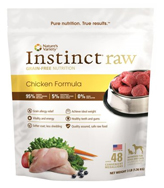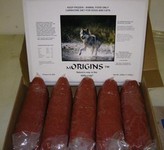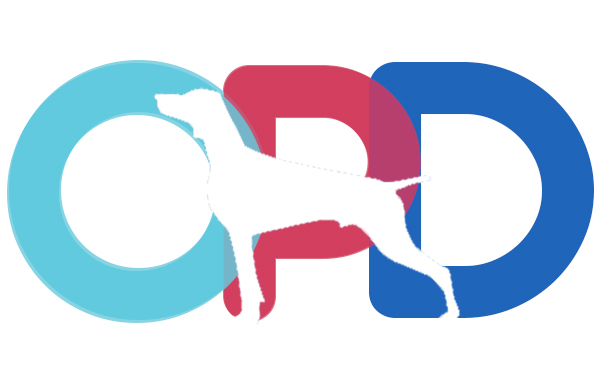In our opinion and experience, YES! But there are a few important safety factors to consider before diving into a raw food diet for your dog…
- How some leaders disagree
- What is the best raw food for my dog?
- How do I transition my dog to a raw diet?
- How should I store raw food?
- Good raw food brands
- Recommended reading
Leading Experts Opinion About a Raw Natural Dog Food Diet
Raw Dog Food Company President Weighs In
Laurie Montean, President of mORIGINS raw dog and cat food, shares her findings with Organic Pet Digest about a raw natural dog food diet:
Unfortunately, not all of the “experts” completely agree about the safety of raw dog food….
- Where they disagree
- Where they agree
Where the Experts Disagree
Obviously the more conservative route is to at least partially cook all raw food, especially raw meat, but that may not be the most beneficial to your dog’s health. As always, you should decide for yourself after reading this page after consulting with your local holistic vet.
From our research, the majority of veterinary experts (including our Holistic Veterinary Council) appear to be in favor of a raw food diet. The fresher the raw food, the more nutritious and safer it will be. Here are a few of their opinions:
Richard Pitcairn
In his book Dr. Pitcairn’s Complete Guide to Natural Health for Dogs & Cats, Dr. Pitcairn states, “My clinical experience over the last 27 years confirms” that “a diet of cooked foods alone will not maintain your pets in top-notch condition… The difference in many animals given a home-prepared, raw food diet after eating processed foods most of their lives is nothing short of amazing.”
Joan Weiskopf
“Cook the meat… The risk of bacterial infection is too high, and the consequences too dire, not to cook the meat.”
Juliette de Bairacli Levy
In her The Complete Herbal Handbook for the Dog and Cat book, Dr. Levy states, “Raw meat should form 75 per cent of the diet of every carnivorous animal…The main reason why dog owners cook meat is the sheer superstition that such food is made more safe…the feeding of meat or milk destroyed by being submitted to the forces of heat will only bring positive health degeneration.”
Where the Experts Agree
Regardless of which advice you decide to take – raw, cooked or processed natural organic dog food – there seems to be a general consensus that:
Is your dog taking immune-suppressing drugs?
Always be careful of raw meat if your dog is taking an immune-suppressing drug as the drug can increase the likelihood of infections.
- A diet of completely raw meat and bones is not entirely beneficial since most domesticated dogs are not active enough to process all of the rich nutrients. In other words, the lower the level of your dog’s physical activity, the less raw meat they should be fed.
- Unless they are extremely fresh, if you decide to introduce fish, rabbit or pork, be sure to cook them first to kill parasites that are often found in these animals.
- Raw bones are great, but do NOT cook them, as cooked bones will soften which increases the likelihood that they will break. The shards from a broken bone can hurt your dog.
- Always cook grains.
- Some vegetables can be served raw, others should be cooked (list below).
- Do not OVERcook the foods as it will destroy many of the beneficial nutrients.
- Any raw or other foods purchased should be certified organic (“organically raised,” “chemical free,” etc.) for their many beneficial aspects over most commercial dog food.
- Be especially careful when serving raw meat to older dogs and sick dogs as their systems may not be able to handle it.
If you decide to serve raw natural dog food, always gauge your dog’s reaction and act accordingly. There will usually be an adjustment period whenever you introduce a new diet. Many alarming symptoms can show up that are completely normal. They are simply your dog’s body’s way of ridding itself of toxins. Take special care when transitioning your dog to a raw food or any other new diet and learn what to expect.
Quick-Searing
If you want to play it “middle-of-the-road”, you can reduce the risk of contamination by quickly searing the outside of the meat or by placing the meat in boiling water for 30 seconds.
What is the Best Raw Food for My Dog?
This section dives into the details of which raw foods to feed and how much, including…
- Meats
- Eggs & Dairy Products
- Beans
- Grains
- Vegetables
If you decide to take the raw food route for your dog, meat (or other high-protein sources) should make up between 55% and 70% of their diet. Less expensive protein substitutes for meat include eggs, dairy products and beans. This is consistent with the proportion that wild dogs have evolved to eat.
The remainder of their diet should consist of a balance of grains and vegetables.
Raw Meat for Dogs
Raw food for dog health, especially raw meat, has at least one overwhelmingly positive argument going for it – it is the closest thing most dog owners have to the food dogs evolved to eat. Meat is the most natural food for carnivores as it is rich in protein and other vitamins and minerals needed most by dogs.
Even state of the art food processing cannot mimic the complex nutritional value of fresh raw meat. And partially cooking meat can destroy its most beneficial attributes.
Raw Liver Limit
Raw liver is said to have many health benefits, but do not make it more than 10% of the raw meat that you feed your dog. You can either obtain liver from your local butcher or in the frozen meat section of the supermarket.
As a rule of thumb, the fresher the meat the better. Below are some tips on storing raw natural dog food that your dog won’t eat within two or three days of purchase.
If you are on the fence about raw meat, you may want to first try turkey, duck or raw lamb dog food instead of cattle, chicken or pork as the latter have higher cancer rates. It is also a good idea to use a variety of meats with different cuts to more closely mimic the dog’s diet in the wild.
You can also sprinkle meat-drippings or low-sodium soy sauce over tofu for a great meat substitute. As always, make sure that the meat you purchase has been organically raised.
Important: NEVER feed your dog raw fish or raw pork.
Raw fish can contain flukes, a parasite that specifically infests the liver in mammals.
Raw pork can contain trichinosis (also called trichinellosis or trichiniasis), which is a parasitic disease caused by eating raw or undercooked pork or wild game infected with the larvae of a species of roundworm called Trichinella spiralis (commonly called the trichina worm).
Trichinosis can be embedded in pig muscle tissue through cysts, and cooking the pork until the internal temperature reaches 170° F (76.7° C) will kill any present.
Pork is not commonly found in dog food anyway, except to add fat and flavor to the recipe (bacon, ham, etc.). With so many of our domestic dogs prone to pancreatitis, diabetes, hypothyroidism, they tend to have a more difficult time with pork even when it’s cooked.
Eggs & Dairy Products for Dogs
Another good substitute for meat as a source of protein are eggs and cottage cheese. Yogurt is also a good alternative, as it contains acidophilus which helps to prevent the overgrowth of yeast in the body.
Beans for Dogs
Beans are a very inexpensive source of protein and can allow you to reduce the amount of raw meat in your dog’s diet. Split peas and lentils are preferred.
Taylor Tips!Soak longer-cooking beans overnight to reduce gas after your dog eats them. Not that a proper lady like me has ever had gas. You know…um…that’s what a friend at the dog park told me happened to her. |
Grains for Dogs
Carbohydrates should be the second largest part of your raw natural dog food diet next to protein, and grains are a great source. They also include important vitamins and minerals.
The best grains are cornmeal, oatmeal, millet and bulgur. And remember – grains should always be cooked!
Vegetables for Dogs
Vegetables are an extremely valuable source of vitamins and minerals. In the wild, dogs eat digested fruits and vegetables in the digestive organs of their herbivorous prey and as herbal medicine to heal themselves and boost their immune system.
Many dog owners even report better dog health after beginning a vegan or vegetarian diet for dogs.
Regardless of what percentage veggies make up of your dog’s diet, always rinse them thoroughly whether.
These are the most nutritious raw vegetables for your dog:
- Alfalfa sprouts
- Bell peppers
- Carrots (can be cooked as well – also gives ‘em something good to chew on!)
- Chopped parsley
- Finely grated beets
- Finely grated carrots with peel
- Finely grated zucchini and other soft squash with peel
- Fresh corn
- Lettuce and mixed greens
…these are the most nutritious cooked vegetables:
- Broccoli
- Cauliflower
- Corn
- Green beans
- Hard winter squash
- Peas
- Potatoes
…and these should be avoided:
- Onions
- Rhubarb
- Spinach
- Swiss chard
- Tomatoes
Describe your dog and his or her history to our veterinarians via My Online Vet. We’ll get back to you right away with specific dietary recommendations for your dog. Food-related questions from other visitors can be found at the bottom of this page.
You can also review related questions from other visitors here:
How To Transition Your Dog to a RAW Diet
While we usually recommend a completely RAW diet (do NOT feed raw fish or raw pork), there are a few things to keep in mind when making the transition…
1. How picky is your dog?
Large Vs. Small Breeds
Larger breeds of dogs seem to prefer the RAW, more natural foods compared to toy or smaller breeds of dogs.
Dr. Tillman’s theory is that the smaller/toy breeds are ‘further’ away (more genetically altered) from their wolf ancestors.
If your dog is a picky eater, you’ll need to be more patient and add smaller amounts of the new raw food into the current diet. It will take a longer time to get them completely over to the new raw diet (2 to 4 weeks) versus a dog that immediately likes the raw food.
2. How sensitive is your dog’s digestion?
If your dog has a sensitive stomach, they may get diarrhea or vomiting with a transition to ANY new diet, including a raw one. Keep in mind that raw diets cause fewer allergic reactions than cooked food, so the transition will often treat the problem and improve their health. A raw diet is SO much healthier for a dog, that this longer transition period will be well worth it for the health and well being of the dog in the long run!
In the case of a dog with a sensitive tummy, transition them VERY slowly, adding in only very small increments of the raw food (1 to 2 tsp) to the current diet per day.
3. How much time and money is spent on food preparation/shopping for dog food for your dog?
As an owner, you must be very dedicated to improving your dog’s diet and finding which food works for your budget, your schedule and your dog’s health… decisions such as making a homemade diet (less expensive) versus a ‘store-bought’ raw diet that comes frozen. When considering costs, keep in mind that a RAW diet is likely to keep your dog much healthier as time goes on, so you’re likely to spend a lot less on vet bills down the road.
From a convenience standpoint, raw diets are available in freeze-dried or dehydrated formats, that are more useful on short term vacation trips when frozen foods would be impractical. At home, a frozen (and then thawed) raw diet is the best.
4. Pre-existing health issues that might make it more difficult to transition your dog to a RAW diet (or any other diet)
While the following conditions take some additional consideration when making the transition, in my experience dogs with ALL of them do MUCH better on a raw diet.
- Diabetes
- Pancreatitis
- IBS (Inflammatory Bowel Syndrome)
- Chronic Diarrhea
If your dog has any of these conditions, see the box below…
Dog Diseases That Require More Careful RAW Diet Transition
Diabetes – If a dog is on insulin, any change in diet may require a change in the dose of the insulin. If the dog does not want to eat the food as the percent of raw is increased, then the dose of insulin will need to be adjusted accordingly that day. Since the dog’s health is likely to improve on a 100% raw diet, the dose of insulin may need to be decreased. Careful monitoring by the owner with a home glucometer or visits to the veterinarian to continue checking the blood sugar may need to be done to get the dog regulated on the raw diet.
Pancreatitis – Overall, a RAW diet is much healthier, but a dog with pancreatitis has a difficult time digesting fat and therefore any diet (raw or cooked) will need to be LOW fat. Also, a raw diet actually contains some of the enzymes needed for digestion, and so raw food will actually be easier for them to digest.
IBS (Inflammatory Bowel Syndrome) – This condition is a chronic issue that requires more fiber and more moisture. So, a raw diet would need to have more cooked vegetables included to adjust to this problem. Adding in canned pumpkin, steamed or canned green beans, zucchini or squash usually works well.
Chronic Diarrhea is another problem that needs to be addressed with the addition of probiotics (acidophilus) to the raw diet. Also consider homeopathic treatment to take care of the underlying illness of the patient.
How to Store Raw Natural Dog Food
You should freeze raw meat if you are not going to feed it to your dog within a couple of days. Freezing meet does destroy some of the nutrients, but it is still far better than most commercial dog food.
Thaw the frozen raw natural dog food in the fridge 24 hours before you are ready to serve it. If it is not completely thawed, add a little hot water – it will also make the food taste better!
What are the Best Raw Natural Dog Foods on the Market?
The best choice is to prepare your dog’s diet at home using local, organic meats and vegetables from trusted farmers – you’ll save money, keep your dog healthy and support your local farmers.
If you want to go the store-bought route, here are a few solid raw natural dog foods that we have had good experiences with…
| Best Raw Natural Dog Foods on the Market | |
|---|---|
 Nature’s Variety Instinct Raw Frozen Lamb Chub |  Nature’s Variety Instinct Raw Medallions |
 | |
Recommended Reading: Raw Dog Food
Our two favorite (non-OPD) resources for raw dog food diets – and dog diets in general – are:
- Fresh Food & Ancient Wisdom: Preparing Healthy & Balanced Meals for Your Dogs, a new book by Dr. Ihor Basko
- Natural Health for Dogs and Cats, an old favorite by Dr. Richard Pitcairn
Do you believe in holistic pet care? If so, please tell your friends about us. Thank you for supporting our efforts!
